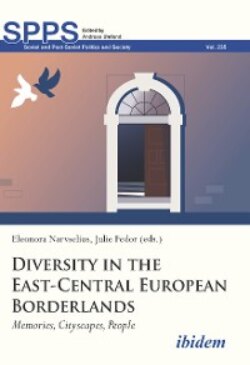Читать книгу Diversity in the East-Central European Borderlands - Группа авторов - Страница 27
На сайте Литреса книга снята с продажи.
Wrocław–Breslau Interwar Breslau in Historical Context
ОглавлениеHistory had shaped the interwar structure of Wrocław/Breslau: the oldest town district on and around the river islands, the planned medieval town, for centuries surrounded by fortifications, and the new city districts outside the fortifications. The Cathedral Island with several medieval churches is the oldest core. Magnificent buildings and churches reflect the flourishing cultural life of late medieval Wrocław/Breslau as a rich Hanseatic and ecclesiastical center.
Interwar Breslau, first mentioned around 1000, was a 95% German-speaking city, although its history also included periods under Bohemian, Polish, Hungarian, and Austrian rule. German language and culture dominated from the thirteenth century, but for centuries there were also Poles, Czechs, Jews, and some Walloons and Frenchmen living in the city. The Protestant faith became dominant from the 1520s, but Roman Catholicism was nevertheless sustained. From 1811 the University had theology departments for both Roman Catholics and Protestants. In 1854 a Jewish Theology Seminary opened. From 1827–29, the district around the White Stork Synagogue (Wallstraße etc)73 had a largely Jewish character with association premises, schools, and canteens.74 A large number of theologians, medical scientists, philosophers, writers, poets, and composers worked in the city.
Figure 2.10. Wrocław. Streets where inhabitants and users in 1936 are registered, according to archival material. Map by the author. Background map from the 1930s, provided by Arno Selten.
From 1871 Breslau rapidly developed as an industrial, cultural, and commercial center with buildings conveying a metropolitan image.75 Of 422,000 inhabitants in 1900, 58% were Protestants, 37% Roman Catholics, and 5% Jewish; 5% were Poles or Czechs. The Jewish population, around 30,000 in 1930, was well integrated into the German society and played a prominent role in science, culture, and business, reflected in the magnificent New Synagogue from 1865–72.76 Jewish commercial houses were precursors of new architecture, such as the Barasch department store in Art Nouveau and the early modernist Petersdorff and Wertheim department stores. Six out of 11 Nobel Prize winners with connections to Breslau had a Jewish background.77 Modern urban planning and architecture developed rapidly. The Jahrhunderthalle (Centennial Hall) from 1913, designed by Max Berg and Hans Poelzig, was included in UNESCO’s World Heritage List in 2006. Modernism broke through in the exhibition Wohnung und Werkraum in 1929, arranged by the architect Hans Scharoun and others. The housing districts Pöpelwitz78 and Zimpel79 were at the forefront of European settlements.80
The main commercial center comprised Ringplatz, Blücherplatz, and Schweidnitzer Straße. Many cafés, restaurants, theaters, cinemas, and hotels were located at Tauentzienplatz and around Gartenstraße near the main station. Near the Centennial Hall was a fashionable villa district. The northern district had a working-class character, with small local shops. Along Kletschkauer Straße lived numerous artisans and people employed by the railway or local public transport, many with Polish names.81 The interwar population increased to 600,000. However, many Poles left for re-constituted Poland and their share decreased to 1% (Thum 2011: xvii).
Figure 2.11. Wrocław. Buildings and business activities in 1936 around Ringplatz (present Rynek). Map by the author. Background map: from Plan der koeniglichen Haupt- u. Residenzstadt Breslau, Staedtisches Vermessungs-amt, Breslau 1910, available at http://www.posselt-landkarten.de.
Figure 2.12. Wrocław. Buildings and business activities in 1936 around Wallstraße (present-day ulica Pawła Włodkowa) and Antonienstraße (present-day ulica Świętiego Antoniego). This was the old Jewish center of Breslau. Map by the author. Background map: details as for Figure 2.11.
From February 1933, Nazi rule brought a drastic and rapid change in the city life and culture: In March, concentration camp in the Dürrgoy suburb;82 in April, a boycott of Jewish shops; and in May: book burning. From September 1935 the Nuremberg laws deprived Jews of civil rights, step by step. Jewish companies and stores were “Aryanized.” Thousands of Jews emigrated, but 10,000 remained at the Kristallnacht in 1938, when the New Synagogue was destroyed, and around 2,500 people sent to concentration camps. The Centennial Hall was used in manifestations such as Hitler’s visit in March 1933 and the 125th anniversary of the Iron Cross Foundation in 1938.
Large urban planning projects were designed to glorify the new regime. A north-south and an east-west axis were proposed.83 A National Socialist Forum was planned as a space of 400 x 800 meters from Schuhbrücke and Ritterplatz to Lessingstraße, connected with a regional government building, a Volkshalle, and a seventy-meter-high clock-tower. This project would imply demolition of the market hall (1909), the regional government building (1883–86), the Akademie für Kunst und Kunstgewerbe (1911), and the former Bernardine monastery from the 15th–16th centuries. The project was never implemented, but a neo-classicist Silesian government building, still used by the regional government, was erected at Lessingplatz.84
